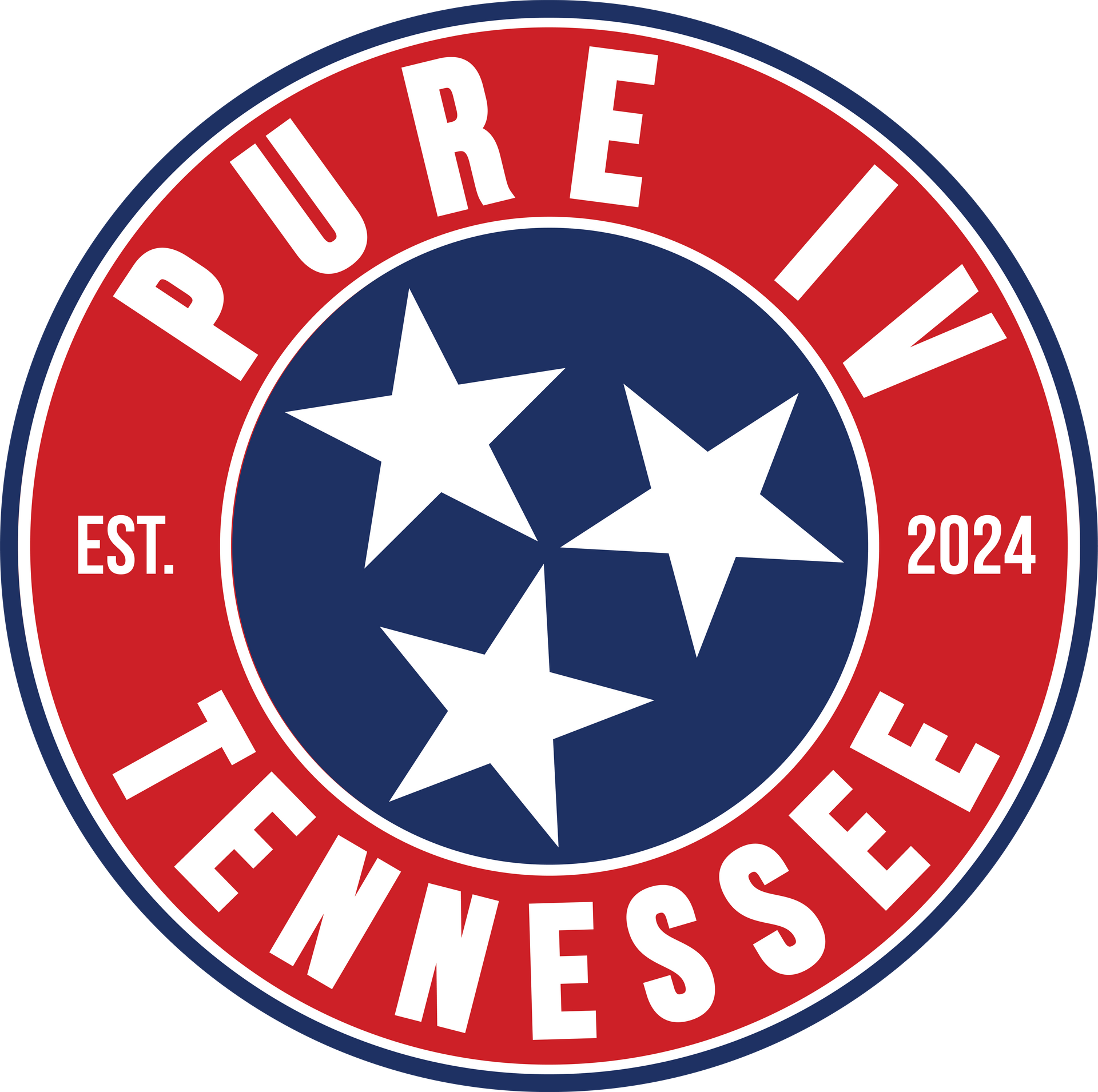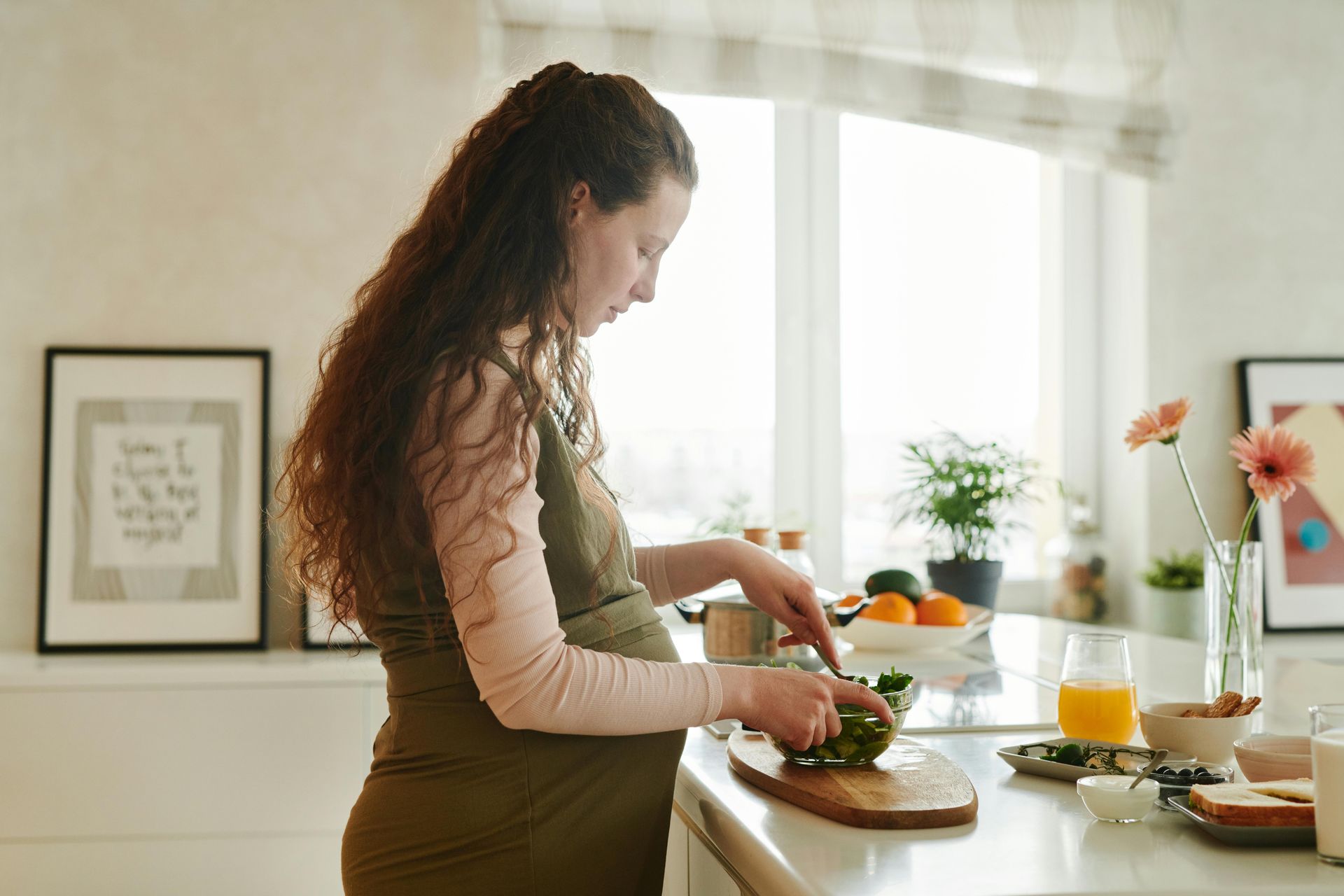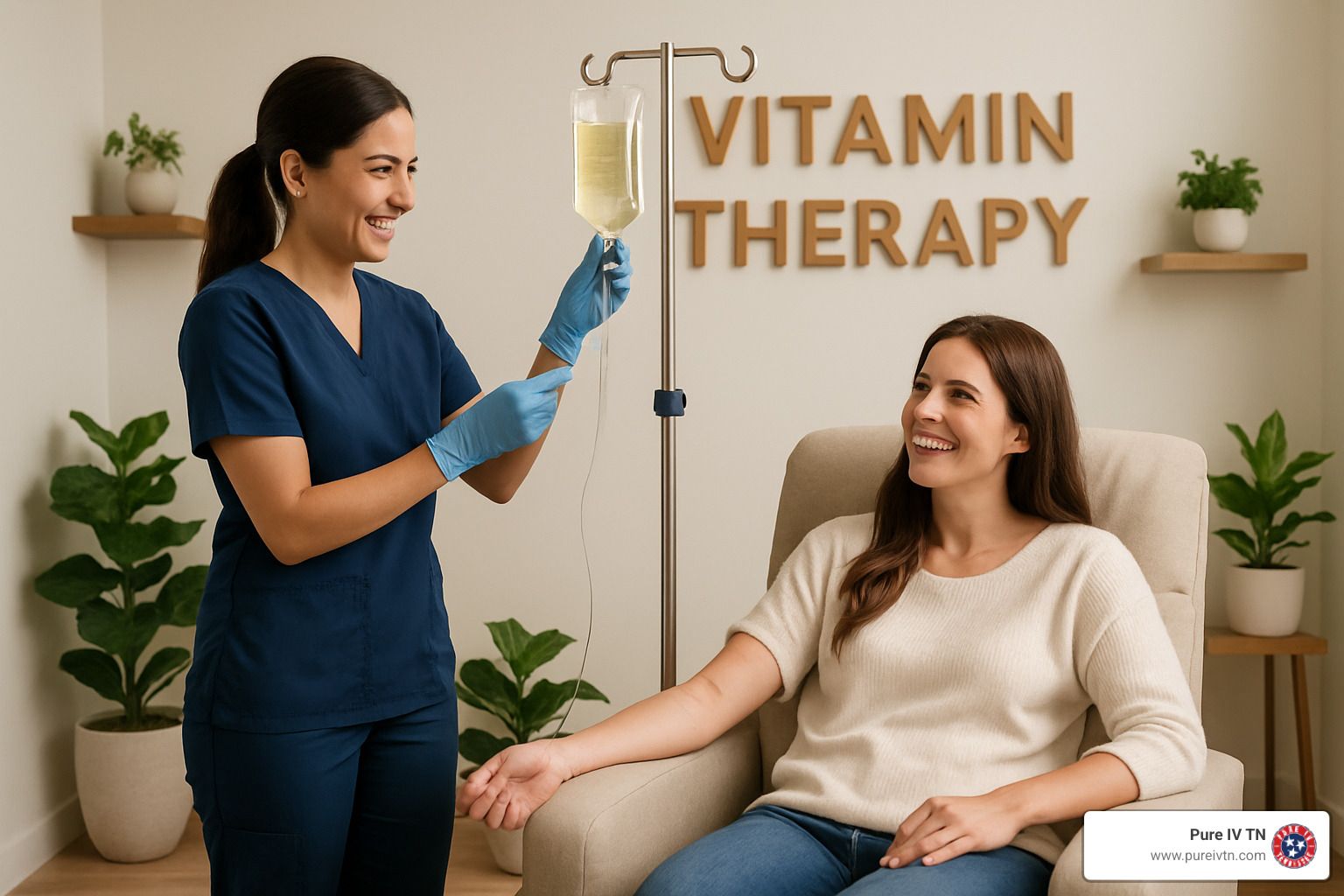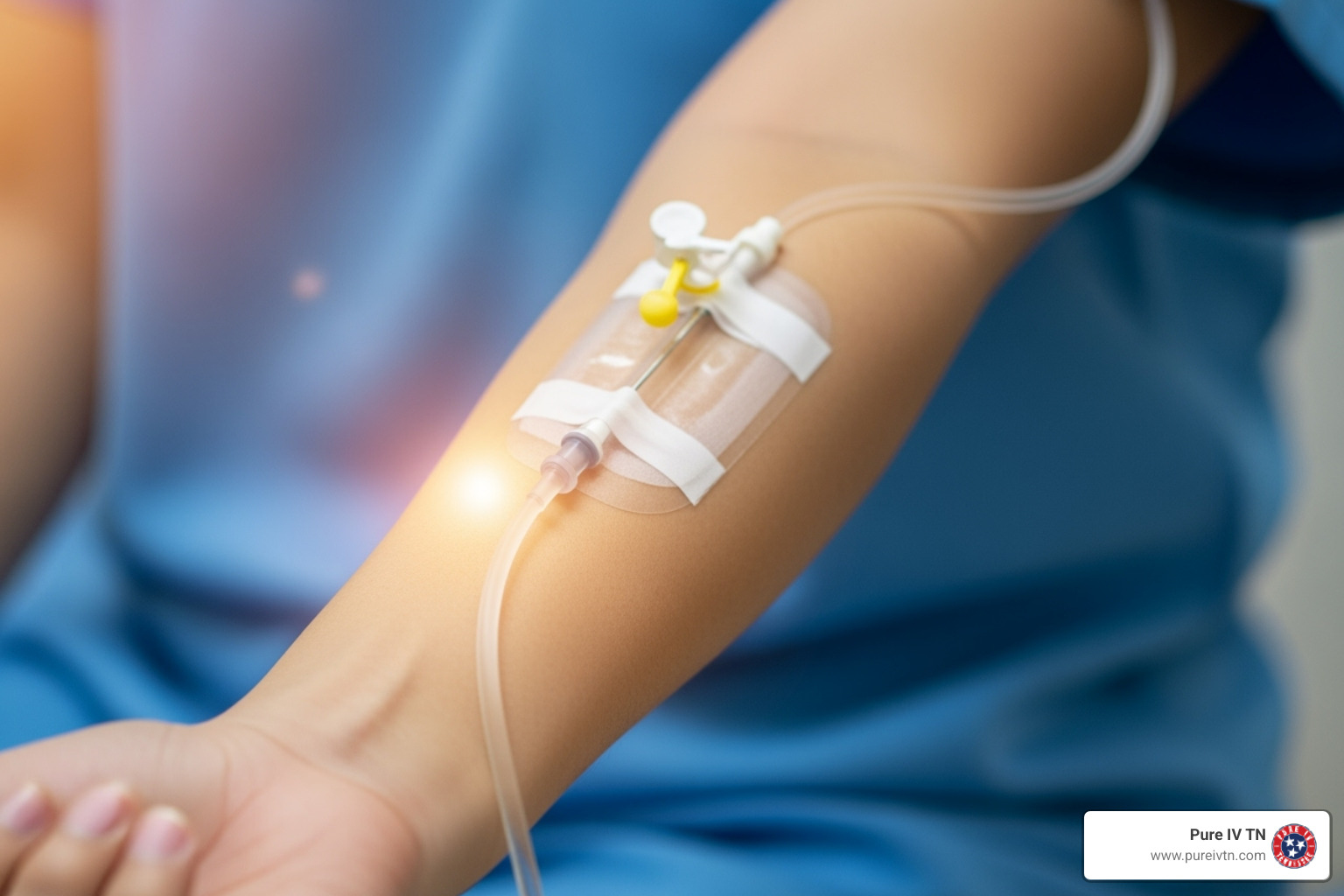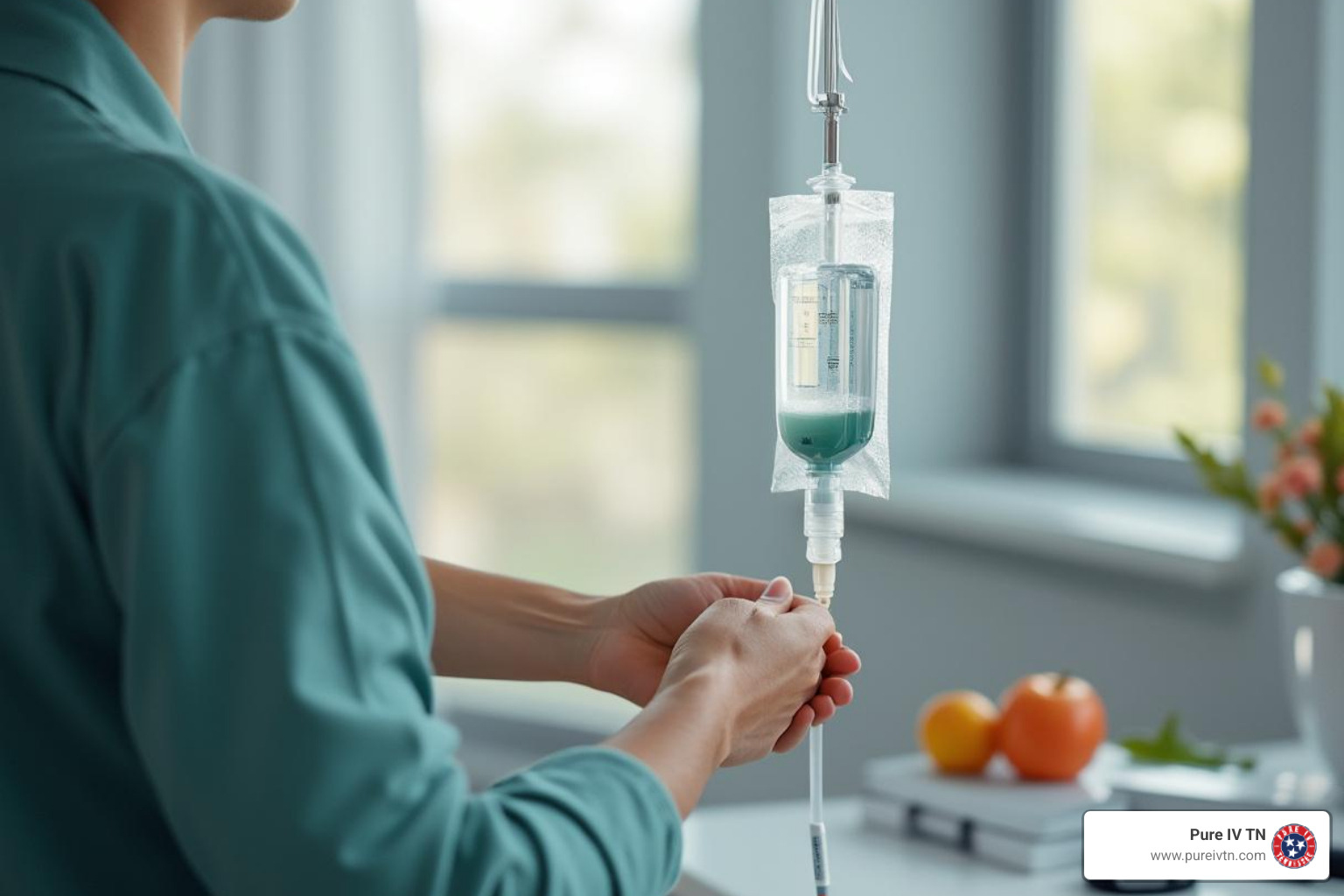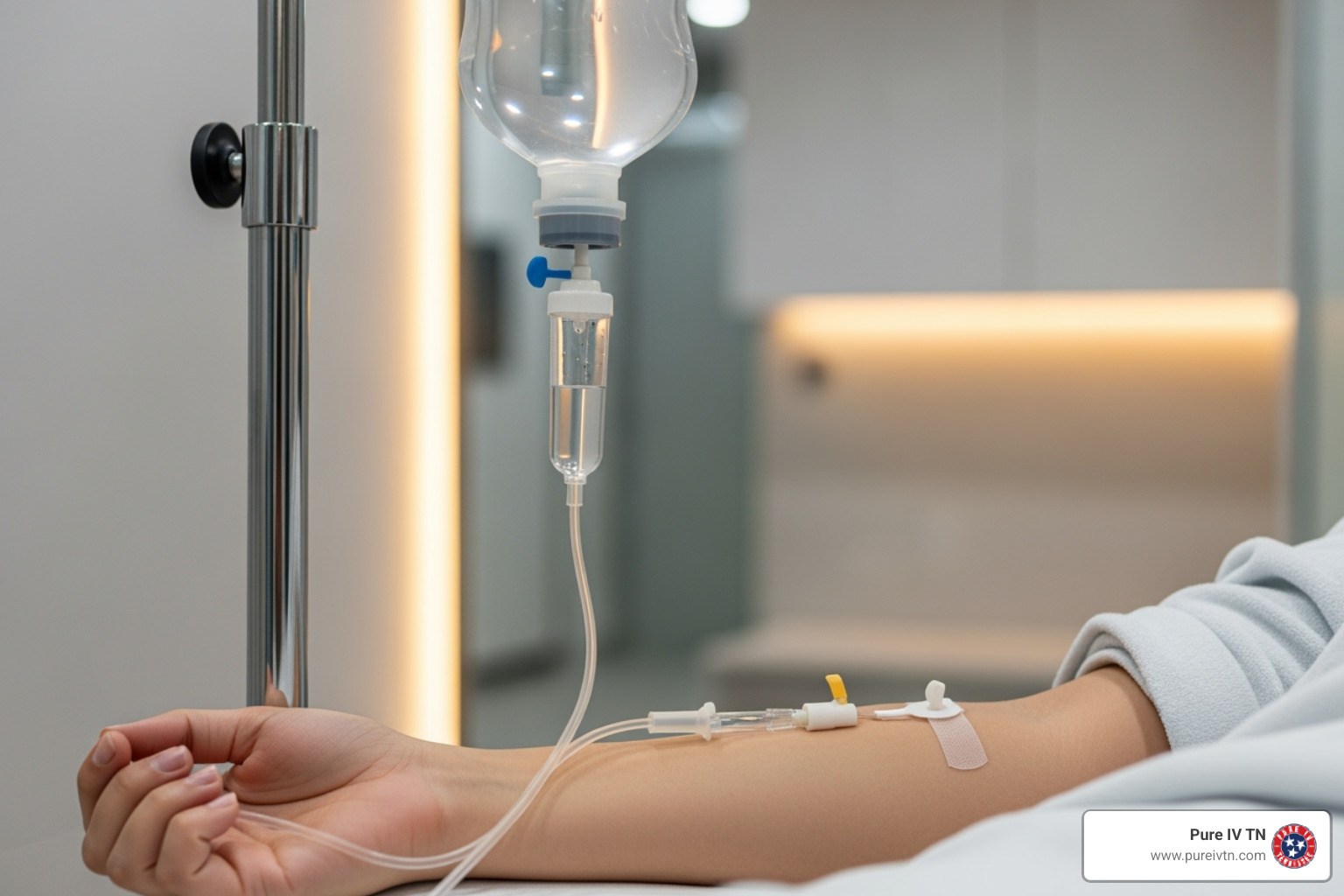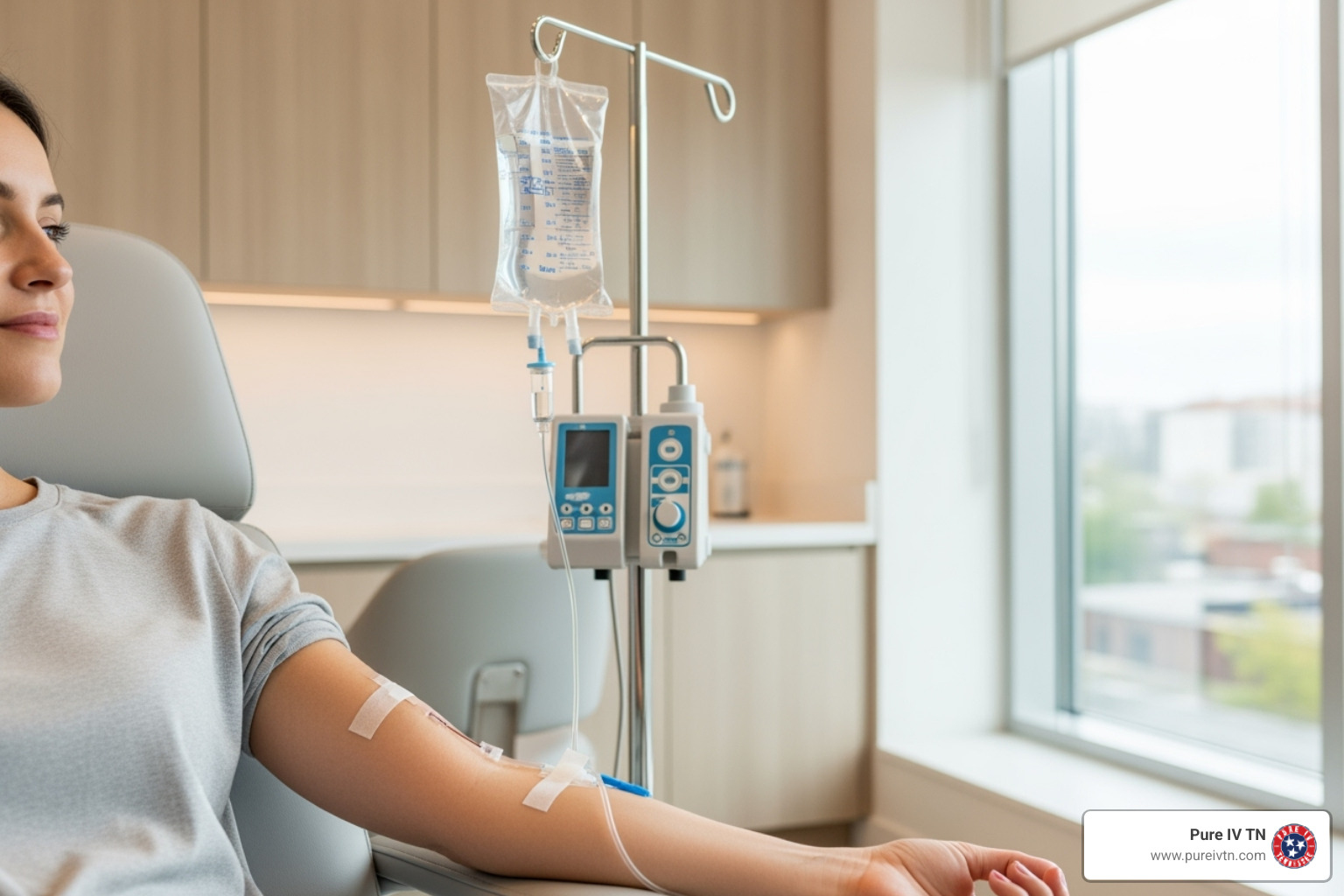IV Therapy for Food Poisoning: Fast Relief & Recovery
When Food Strikes Back: The IV Solution

IV therapy for food poisoning is a medical treatment that delivers fluids, electrolytes, and medications directly into your bloodstream to rapidly relieve symptoms and prevent dehydration. Here's what you need to know:
| IV Therapy for Food Poisoning | Quick Facts |
|---|---|
| How it works: | Bypasses digestive system to deliver hydration and medications directly to bloodstream |
| Key benefits: | Rapid rehydration, immediate symptom relief, 100% nutrient absorption |
| What's included: | Saline, electrolytes, anti-nausea medication, vitamins (B complex, B12, C), zinc, glutathione |
| Time to relief: | Most patients report improvement within 30 minutes |
| Treatment time: | Typically 45-60 minutes |
| Delivery method: | Mobile service to your home/hotel or at clinic locations |
Few things can derail your day faster than food poisoning. One minute you're enjoying a meal, and the next you're making urgent trips to the bathroom with nausea, vomiting, and diarrhea. Food poisoning affects an estimated 48 million Americans annually, leading to about 128,000 hospitalizations and 3,000 deaths.
When food poisoning strikes, dehydration becomes your biggest enemy. The rapid loss of fluids and electrolytes through vomiting and diarrhea can leave you feeling weak, dizzy, and unable to function. While drinking water helps, severe cases often require more intensive hydration.
That's where IV therapy comes in.
Unlike oral hydration that must pass through your already-irritated digestive system, IV therapy delivers fluids, electrolytes, and medications directly into your bloodstream. This approach provides immediate relief and helps your body recover faster.
Why mobile IV therapy makes sense:
- No travel required when you're feeling terrible
- Faster absorption than oral fluids
- Immediate symptom relief with anti-nausea medications
- Customizable formulas for your specific symptoms
- Professional administration by licensed nurses
I'm Joseph Lopez from Pure IV Tennessee, with extensive experience administering IV therapy for food poisoning to clients throughout Nashville and surrounding areas, helping them recover quickly from foodborne illness symptoms and return to their daily activities without the inconvenience of hospital visits.
Food Poisoning 101: Causes, Symptoms & Complications
Ever had that sinking feeling when your stomach turns against you after a meal? Food poisoning happens when those tasty bites you enjoyed were actually harboring some unwelcome guests.
The culprits behind your digestive distress typically fall into four main categories: bacteria like E. coli and Salmonella, viruses such as Norovirus , parasites like Giardia, and natural toxins from certain mushrooms or improperly handled fish. These microscopic troublemakers can turn your digestive system upside down within hours – or sometimes days – after eating.
When food poisoning strikes, your body sends clear distress signals: nausea, vomiting, diarrhea (sometimes bloody), cramping, fever, headaches, and fatigue that makes even getting out of bed feel impossible.
Most healthy adults bounce back from food poisoning within a few days. But here's the real danger – dehydration . When you're losing fluids faster than you can replace them, your body's electrolyte balance gets thrown off, creating a potentially serious situation.
Some folks face greater risks when food poisoning strikes. If you're over 65, under 5, pregnant, or living with chronic illness or a compromised immune system, you'll want to be especially vigilant. In severe cases, food poisoning can lead to serious complications like kidney failure, chronic arthritis, or even nerve damage if left untreated.
Common Culprits in Your Kitchen
Believe it or not, many food poisoning cases begin right where you prepare your meals. Cross-contamination happens when bacteria from raw chicken or meat hitchhike onto your fresh salad ingredients via your hands, cutting boards, or countertops. Always keep raw meats separate from ready-to-eat foods and wash your hands thoroughly after handling raw ingredients.
Undercooked meat is another frequent offender. Those juicy burgers need to reach 160°F internally to kill harmful bacteria, while chicken requires 165°F. Invest in a good food thermometer – it's much cheaper than a hospital bill!
Improper food storage creates a perfect breeding ground for bacteria. Remember the two-hour rule: refrigerate perishable foods within two hours of preparation (or one hour if it's a hot summer day above 90°F). Keep your fridge at or below 40°F to keep those bacteria at bay.
Red-Flag Symptoms That Need a Doctor
While most food poisoning cases resolve with home care, some symptoms should send you seeking medical help immediately:
Bloody stool or vomit isn't something to ignore – it could signal a severe infection or internal bleeding. High fever (above 101.5°F in adults) suggests your body is fighting something serious. If you're experiencing persistent vomiting and can't keep any fluids down for more than 24 hours, your dehydration risk skyrockets.
Severe abdominal pain that's constant or localized might indicate complications beyond simple food poisoning. Watch for signs of severe dehydration too – extreme thirst, dry mouth, minimal urination, severe weakness, or dizziness when standing up. Any neurological symptoms like blurry vision, muscle weakness, or tingling sensations are red flags that shouldn't be ignored.
And if your symptoms haven't improved after three days, it's time to seek professional help. At Pure IV TN, we understand how debilitating food poisoning can be, which is why our IV therapy for food poisoning services are designed to help you recover faster and more comfortably than suffering through it alone.
Hydration Is Half the Battle: Oral vs. IV Fluids
When food poisoning hits, your body faces a serious math problem. Diarrhea and vomiting can drain 5–10 liters of fluid in a single day—far more than the 2–3 liters most of us can comfortably drink. You’re not just losing water; every episode also pulls out crucial electrolytes like sodium, potassium and chloride.
Think of electrolytes as your body’s electrical system—without the right charge, nerves misfire, muscles cramp, and pH balance drifts. Replace them quickly and you feel human again; lag behind and dehydration becomes dangerous.
Oral vs. IV at a Glance
| Factor | Oral Rehydration | IV Hydration |
|---|---|---|
| Absorption Rate | Slow (1–2 h) | Immediate |
| Bioavailability | ~50-60 % | 100 % |
| Works With Nausea? | Often vomited back up | Yes—bypasses GI tract |
| Electrolyte Replacement | Partial | Complete & precise |
| Medication Delivery | Limited | Direct & immediate |
| Speed of Symptom Relief | Hours | Minutes |
| Convenience | Self-administered | Nurse-administered |
For mild cases, both the World Health Organization and CDC endorse special oral rehydration solutions. They’re a solid first line of defense, but they depend on a cooperative stomach.
When symptoms escalate, clinicians reach for Ringer’s lactate or normal saline through an IV line. Delivering fluids straight into the bloodstream guarantees 100 % absorption and avoids the “drink—vomit—repeat” loop.
When to Upgrade to IV Fluids
- You can’t keep even small sips of water down.
- Diarrhea exceeds six loose stools in 24 h and is accompanied by vomiting.
- You show signs of moderate to severe dehydration: parched mouth, minimal urine for eight hours, sunken eyes, fatigue or dizziness on standing.
- You belong to a high-risk group—pregnant, young children, older adults or people with chronic illness.
Scientific Proof IV Works Fast
According to the CDC’s rehydration therapy guidelines, properly administered IV fluids can restore normal hydration in as little as 30 minutes, while oral solutions may take several hours. Multiple studies show IV therapy shortens hospital stays for severe gastroenteritis, protects the kidneys from dehydration-related damage and gets patients feeling better far sooner than oral fluids alone.
In short, iv therapy for food poisoning isn’t a luxury—it’s often the fastest, safest route back to feeling like yourself.
How IV Therapy for Food Poisoning Works

When you're doubled over from food poisoning, the last thing your body wants is to swallow more liquids. That's where IV therapy for food poisoning comes to the rescue. Instead of fighting your already irritated stomach, we deliver hydration and medications directly into your bloodstream – no digestive system required!
Think of it as the express lane for recovery. Your nurse will first assess your symptoms and check your medical history. Then, they'll gently insert a small catheter into a vein in your arm – most people say it feels like a quick pinch, and then it's over.
Once that tiny tube is in place, the magic begins. A carefully prepared bag of fluids starts flowing directly into your circulation, delivering instant hydration where you need it most. Your nurse stays with you the entire time, monitoring how you're responding and making sure you're comfortable.
Most of our patients start feeling relief within 15-30 minutes – that's the beauty of the 100% bioavailability that comes with IV therapy for food poisoning .
IV Therapy for Food Poisoning: Key Benefits
The perks of choosing IV therapy for food poisoning go well beyond convenience:
- Rapid symptom relief – most folks tell us they feel dramatically better within half an hour
- 100% bioavailability of all medications and nutrients compared to oral medications
- Bypasses your angry GI tract entirely when your body's in "eject everything" mode
- Energy boost from B vitamins and proper hydration helps lift that crushing fatigue
- Immune support with vitamin C, zinc, and glutathione providing reinforcements
- Customized treatment based on your specific symptoms
For more information about how our treatments can help you bounce back quickly, check out our IV Therapy for Food Poisoning page.
What's Inside a Food-Poisoning Drip?
Your food poisoning IV bag isn't just salt water – it's a carefully formulated cocktail designed to address multiple symptoms at once:
- Normal saline (a liter of 0.9% sodium chloride solution) rapidly rehydrates your cells
- Ondansetron (Zofran) , a powerful anti-nausea medication that works within minutes
- Famotidine (Pepcid) reduces acid production, helping calm the fire in your belly
- B-complex vitamins to support energy production
- Vitamin B12 to boost your immune response
- Vitamin C works as both an immune booster and inflammation fighter
- Magnesium helps relax cramping muscles and ease stress
- Taurine , an amino acid with anti-inflammatory properties
- Zinc provides direct antimicrobial action
- Glutathione helps your liver process and eliminate toxins faster
IV Therapy for Food Poisoning vs. ER Visit
When you're feeling terrible, the emergency room might seem like your only option – but is it really the best one? Let's compare:
- ER wait time : 3+ hours in a room full of other sick people
-
Mobile IV : Typically at your door within an hour, treatment starts immediately
-
ER cost : Between $1,000-$3,000 before insurance (with potential surprise bills)
-
Mobile IV cost : About $300-$400, with transparent pricing and no hidden fees
-
ER comfort : Sitting upright in an uncomfortable waiting room
-
Mobile IV comfort : Stay in your pajamas, wrapped in your favorite blanket at home
-
ER time commitment : 4-6 hours total
- Mobile IV time : Under an hour complete
To be clear – severe food poisoning with complications like high fever, bloody stool, or signs of sepsis absolutely warrants an ER visit. But for moderate cases where dehydration is the main concern, mobile IV therapy offers a more comfortable, convenient, and cost-effective solution.
Step-by-Step: Your Mobile IV Session

Wondering what happens when you book a mobile IV treatment for food poisoning? Let me walk you through the experience from start to finish:
1. Initial Contact and Screening
When you reach out to us, a nurse will contact you promptly to discuss your symptoms and run through a quick medical screening. This helps us personalize your treatment and ensure IV therapy is the right choice for your situation.
2. Nurse Arrival and Setup
A licensed nurse comes directly to wherever you're resting—your home, hotel room, or office. There's no need to drag yourself anywhere when you're feeling miserable! Your nurse will create a clean treatment space right where you are, using sterile, single-use equipment.
3. Vein Assessment and IV Access
Our experienced nurses are experts at finding the perfect vein for your IV, even if you've been told you have "difficult veins" before. We'll apply a tourniquet, clean the area with antiseptic, and insert a small, flexible catheter—just a quick pinch and it's done.
4. IV Fluid Administration
Once your IV is placed, we'll connect your customized one-liter solution. The drip rate is carefully adjusted for your comfort, and medications like anti-nausea and anti-inflammatory agents are administered through the line. The whole infusion typically takes 45-60 minutes.
5. Monitoring During Treatment
Your nurse stays with you throughout, monitoring your vital signs and checking the IV site regularly. This is a great time to rest—you can watch TV, scroll through your phone, or even take a nap.
6. Completion and Post-Care
When your infusion is complete, we'll gently remove the catheter, apply a small bandage, and provide personalized aftercare instructions. We clean up everything before leaving.
7. Follow-Up
We'll check in with you the next day to see how you're feeling and provide any additional recommendations based on your recovery progress.
IV Therapy for Food Poisoning: Timeline of Relief
When you receive IV therapy for food poisoning , relief follows a fairly predictable timeline:
Within 15 minutes , you'll likely notice the first signs of improvement. That overwhelming nausea begins to subside as the anti-nausea medications enter your bloodstream directly. Any headache pain starts to ease, and as initial hydration begins, you'll feel more alert.
By the 30-minute mark , most patients experience significant relief. The nausea and vomiting substantially decrease, cramping abdominal discomfort begins to fade, and you'll notice a welcome boost in energy as your cells receive the hydration and nutrients they've been needing.
As the treatment completes (usually around 45-60 minutes), you'll experience substantial relief from most acute symptoms. Your hydration status will be restored, and you'll be able to start transitioning back to oral fluids.
In the hours following treatment , improvement continues. Within 2-4 hours, most patients can tolerate small amounts of food again, and by the 24-hour mark, the majority report feeling dramatically better.
Safety, Risks & Who Should Skip IVs
While IV therapy for food poisoning offers tremendous benefits, it's not right for everyone. Potential risks include infection (though rare with our strict sterile techniques), infiltration (fluid leaking into surrounding tissue), vein irritation, allergic reactions, or in very rare cases, fluid overload.
Some health conditions make IV therapy less appropriate, including congestive heart failure, severe kidney disease, history of severe allergic reactions to medications in our formulas, certain blood disorders, or poorly controlled severe hypertension. If you're running a high fever (above 101.5°F), you might need different medical intervention first.
At Pure IV TN, safety is never compromised. We conduct thorough medical screenings, employ strict sterile techniques, monitor vital signs throughout, and maintain physician oversight of all protocols. The most important thing you can do for your safety? Be completely honest during your screening.
Beyond the Drip: Prevention & Supportive Care
Let's face it—recovering from food poisoning isn't fun, but preventing it altogether is even better. While IV therapy for food poisoning works wonders when you're already sick, here's how to avoid that miserable experience in the first place.
Good prevention starts with handwashing—20 seconds of scrubbing with soap and warm water before cooking, after handling raw meat, after bathroom visits, and after petting animals really does make a difference.
In your kitchen, think of raw meat as toxic waste—it needs its own cutting board, separate from your fruits and veggies. Your refrigerator should be a chilly 40°F or below, and remember the two-hour rule: refrigerate perishable foods within two hours of preparation (or just one hour if it's a hot summer day above 90°F).
Cooking food thoroughly kills most pathogens, so invest in a food thermometer instead of guessing. Chicken and turkey need to reach 165°F , while ground meats should hit 160°F .
Post-IV Recovery: Getting Back on Your Feet
After your IV therapy for food poisoning session ends, your body still needs some TLC to fully recover.
The BRAT diet isn't just an old wives' tale—it works! Bananas restore potassium lost through diarrhea, rice helps bind loose stools, applesauce provides easy-to-digest nutrients, and toast offers simple carbs that won't irritate your stomach.
Once you've stopped vomiting, consider adding probiotics to rebuild your gut's healthy bacteria population. A good quality yogurt with live cultures or kefir can help restore balance to your digestive system.
Rest is non-negotiable . Your body has been through a battle and needs time to recover. Cancel those plans, put your feet up, and give yourself permission to binge-watch your favorite show for 24-48 hours.
A teaspoon of honey in warm water or tea can actually reduce the duration of diarrhea caused by bacterial gastroenteritis. Plus, it's soothing on an irritated throat if you've been vomiting.
Even after your IV therapy, continue drinking clear fluids to maintain hydration. Water is great, but electrolyte solutions can help replace what you've lost more effectively.
Travel & Food Safety Hacks
Nothing ruins a vacation faster than food poisoning. Whether you're exploring Nashville or venturing internationally, protect yourself with these practical tips.
Water safety should be your top priority when traveling. That bottled water might seem expensive, but it's cheaper than ruining your trip with illness. Check that seals are intact before drinking, and remember that ice cubes are often made from tap water.
When choosing restaurants, busier is usually better. High customer turnover means fresher ingredients and less time for bacteria to multiply.
Street food can be delicious and safe if you choose wisely. Look for vendors cooking food to order right in front of you and serving it hot. Those pre-made sauces sitting out all day? Politely decline.
Some foods carry higher risks when traveling. Raw seafood might be tempting, but it's best saved for places with impeccable food safety standards. Unpasteurized dairy products, buffets where food sits at room temperature, and pre-cut fruits are also common culprits in traveler's food poisoning.
Frequently Asked Questions about IV Therapy & Food Poisoning
How fast will I feel better after an infusion?
That moment when relief finally washes over you after hours of misery? It typically starts just 15-30 minutes into your IV treatment.
Most of our patients notice the nausea subsiding first as the anti-nausea medications enter their bloodstream directly. Meanwhile, the hydration solution begins addressing what's often the most dangerous aspect of food poisoning—dehydration.
By the time your 45-60 minute session wraps up, you'll likely feel like a different person. The change typically includes dramatically reduced nausea, a welcome energy boost, mental clarity returning, less stomach discomfort, headache relief, and an overall sense of "I might actually survive this!"
Complete recovery usually takes 24-72 hours depending on what caused your food poisoning and how severe it is. Think of the IV as your body's reinforcements—it doesn't fight the whole battle, but it gives you the strength to win the war.
Can IV therapy cure food poisoning or just relieve symptoms?
Let's be straight about what IV therapy for food poisoning can and cannot do.
IV therapy isn't a magic bullet that instantly kills the bacteria or virus causing your misery. Your immune system still needs to handle that part. What IV therapy brilliantly accomplishes is managing the fallout—it's like disaster relief for your body.
The therapy excels at rapidly replacing lost fluids and electrolytes, shutting down the nausea and vomiting cycle, calming inflammation, easing pain, and giving your immune system a helping hand. Most importantly, it prevents the dangerous complications that can arise from dehydration.
For particularly severe bacterial infections, you might need antibiotics in addition to IV therapy. In these cases, we'll be upfront about recommending follow-up care with your doctor or an urgent care facility.
Who is an ideal candidate for a food-poisoning drip?
You might be perfect for IV therapy for food poisoning if you find yourself in one of these situations:
-
You're experiencing moderate dehydration with symptoms like ongoing vomiting or diarrhea, inability to keep down even water, noticeably decreased urination, dry mouth, constant thirst, headache, dizziness, or unusual fatigue
-
You can't afford to be down for days due to work deadlines, travel plans, family responsibilities, or important events
-
You have factors that increase your risk of complications: pregnancy (with provider's approval), older age, chronic health conditions, recent weight loss surgery, or history of dehydration issues
-
You're a traveler stuck in a hotel room in an unfamiliar city
During our initial conversation, our nurses will help determine if you're an ideal candidate for IV therapy or if your situation requires emergency department care instead.
Conclusion
Food poisoning can turn a perfectly good day upside down in an instant. One minute you're enjoying a meal, and the next you're stuck in a cycle of nausea, vomiting, and the dreaded dash to the bathroom. While drinking water and resting helps with mild cases, moderate to severe food poisoning demands a more powerful solution to prevent complications and get you back on your feet faster.
IV therapy for food poisoning offers exactly that—quick, effective relief that targets dehydration (your biggest enemy during food poisoning) while simultaneously calming nausea and other miserable symptoms. The beauty of IV therapy lies in its direct approach: delivering everything your body needs straight into your bloodstream, completely bypassing your angry digestive system that's rejecting anything you try to swallow.
At Pure IV TN, we understand that the last thing you want to do when you're sick is drag yourself to an emergency room or urgent care. That's why we bring professional medical treatment directly to your doorstep throughout Nashville and surrounding areas. Our experienced registered nurses come to you with everything needed to help you feel better fast—whether you're curled up at home, stuck in a hotel room, or trying to power through at the office.
When you choose Pure IV TN for food poisoning relief, you're getting:
- Quick response times—often within an hour of your call
- Treatment in your own comfortable space (no cold, uncomfortable waiting rooms)
- A custom IV formula custom specifically to your symptoms
- Care from licensed nurses who understand food poisoning inside and out
- Straightforward pricing with zero hidden fees or surprise bills
- Thoughtful follow-up to make sure you're continuing to improve
Why spend days feeling terrible when relief could be just minutes away? Most of our patients report significant improvement within 30 minutes of beginning their IV treatment, helping them return to work, family responsibilities, or vacation plans much sooner than they expected.
Don't let food poisoning steal more of your time than it already has. With prompt IV therapy intervention, you can short-circuit the misery and get back to living your life.
To learn more about our food poisoning IV therapy or schedule your treatment, visit our website or give us a call today. Feeling better is just one phone call away.

While IV therapy works wonders for most food poisoning cases, please seek emergency care if you experience severe or worsening symptoms like bloody stool, high fever over 101.5°F, or signs of severe dehydration.
